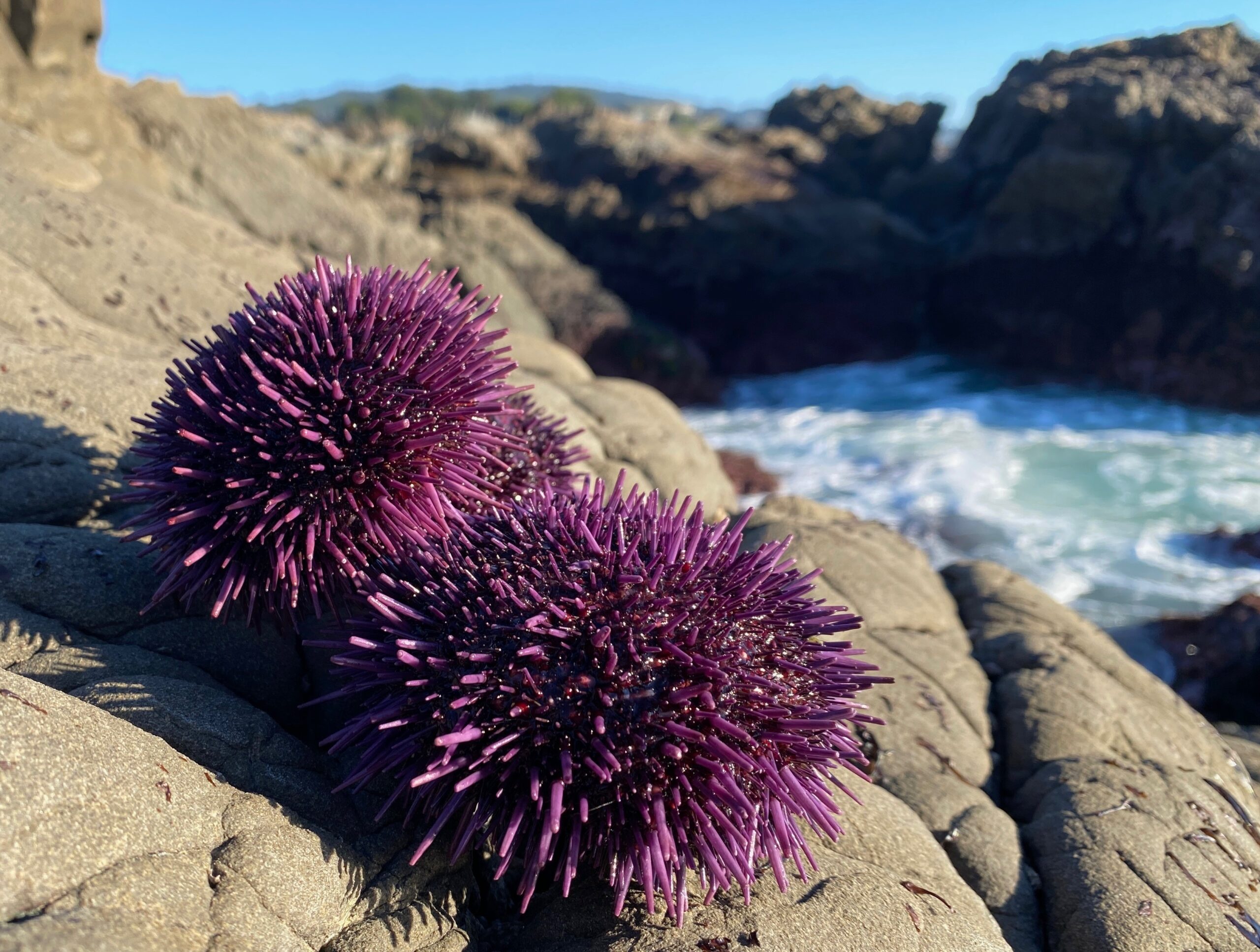Every winter, my family returns to the same rocky cliffside in Sea Ranch, 100 miles north of San Francisco, for one thing: sea urchins. The spiny, purple oceanic critters are smothering the coastline, but those brave enough to forage for them in frigid water are drawn to their sweetly saline gonads, known as uni.
Beyond our family’s cultural roots in Japan, where people eat 9,000 tons of sea urchin roe every year, the costly overpopulation of this less-than-cuddly sea tribble tells a very California story of ecological urgency that is tied up with Japanese American history, too.
By low tide on a late January afternoon, the ocean had sucked back the swells to reveal roaming sea stars, shelves of mussels and, suddenly—thousands of purple urchins.
Prying the urchins from their foamy nooks and crannies takes gusto and timing, since the right wave can obliterate where you were just standing two seconds ago. Ever the daring, methodical adventurer, my brother-in-law had 15 in just under an hour. I, meanwhile, was caught up in my feelings as each urchin’s tentacle-like feet gently probed my palms like the noble Ohmu from Miyazaki’s environmentalist saga Nausicaä.
Scraped knees, soaked socks and several girl-coming-of-age-in-nature moments later, and we were headed home for dinner with a Home Depot bucket brimming with spines.
These same overwordly tidepools around Sea Ranch are where certified kelp restoration diver Ricardo Romero Gianoli fell in love with the ocean. But in 2020, Romero Gianoli was panicked by what he saw.
“I noticed a huge drop in biodiversity off the coastline in December,” he said. “The kelp was disappearing.”
He was right: The tiny but mighty urchin had already devoured 90% of California’s bull kelp by that time.
"The ecosystem is out of whack, and has been for a long time. California sea cows, which are entirely gone, used to play a key role in keeping kelp healthy by trimming the tops of the forest. Pacific sea otters were hunted to near-extinction in the 19th century, largely for their pelts, and a warming ocean has been killing sea stars off in droves. Both species shared one spiny food source, which proliferates in their absence, ravaging the kelp that keeps the marine food chain stable."
Kelp devastation from sea urchins is so extreme that divers like Romero Gianoli take to the ocean floor in full scuba gear to obliterate the creatures with hammers, as part of the Giant Giant Kelp Restoration Project in Monterey.
Other scientists, like biologist Robert Miller at UC Santa Barbara’s Marine Science Institute, aren’t so sure about this method, arguing that the urchin-kelp dynamic is more nuanced.
“We shouldn't necessarily adopt simplistic management approaches like smashing sea urchins to save kelp forests,” Miller said about his research in 2021.
But people like Romero Gianoli are of a branch of the scientific community that believes humans and nature need each other and that our interference—be it via hammers or stomachs—is a good thing.
“There's a tendency in Western, modern environmentalism that in order for nature to be OK, we need to remove humans,” he said. “But we’re learning that’s not true, if people learn to coexist with nature like many Indigenous peoples have.”
One of those contemporary relationships, he says, is between the sea urchin and Japanese Americans, who, starting in the late 1800s, lived in fishing villages around Point Lobos, just south of Monterey. For Romero Gianoli, families who regularly foraged for urchins had taken up the mantle that otters, sea cows and sea stars had left behind.
“This is a story about how humans can be good or bad for the environment,” Romero Gianoli said.
More than 100 years later, Japanese American families like mine still help keep the urchin population in check, albeit one mouthful at a time.
For those who’ve never dared eat any, uni tastes like a creamy, briny mouthful of the ocean herself. It’s rich, luscious and salty—and it’s your moral imperative to try some.
While Romero Gianoli enjoys his uni in paella, I grew up eating urchin roe with steamed rice, a raw quail egg and a splash of soy sauce. By the end of the night after our afternoon of harvesting, my family’s kitchen sink resembled the remnants of a sea otter’s binge sesh.
This year, though, we followed in the hallowed footsteps of culinary deity J. Kenji López-Alt by melting down the roe with cream, garlic and pasta—a trendy uni carbonara that has been making its rounds in Bay Area eateries like Rich Table and Kiraku.
As we gorged ourselves with all the moral superiority we could muster, restoration efforts and the ecosystem’s natural cycles in the face of overpopulation are slowly doing their thing.
“It’s not good,” Romero Gianoli said, “but the urchin problem has gone from dire to a little more hopeful.”
